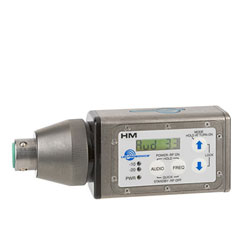|
ASC (Canada) Ltd. Phone (local): 416-251-5409 Sales Rentals Service Carts & Custom Work Specials Consignment Used Goods Downloads Links Contact Us |
|
HM Transmitter
The transmitter provides 256 frequencies in standard frequency blocks, selected with two rotary switches on the side of the housing. The input amplifier uses an ultra low noise op-amp for quiet operation. It is gain controlled with a wide range dual envelope limiter, providing over 30 dB of headroom above full modulation. A 24-bit A-D converter digitizes the audio, then filters supersonic noise above 21 kHz. The resulting signal is encoded with a proprietary algorithm to produce an analog data signal for RF transmission. The underlying RF link is an optimized FM system with +/-75 kHz wide deviation for a high signal to noise ratio. The antenna is formed between the lower housing of the transmitter and the attached system. It functions as a dipole radiator when attached to a hand-held microphone and somewhat like a ground plane antenna when connected into a mixer.
Digital Hybrid Wireless® is a revolutionary new design that combines digital audio with an analog FM radio link to provide outstanding audio quality and the exemplary RF performance of the finest analog wireless systems. This overcomes channel noise in a dramatically new way, digitally encoding the audio in the transmitter and decoding it in the receiver, yet still sending the encoded information via an analog FM wireless link. This proprietary algorithm is not a digital implementation of an analog compandor. Instead, it is a technique which can be accomplished only in the digital domain. The process eliminates compandor artifacts, expanding the applications to include test and measurement of acoustic spaces and musical instruments. Block 470 470.100 - 495.600 Block 19 486.400 - 511.900 Block 20 512.000 - 537.500 Block 21 537.600 - 563.100 Block 22 563.200 - 588.700 Block 23 588.800 - 607.900 and 614.100 - 614.300 Block 24 614.400 - 639.900 Block 25 640.000 - 665.500 Block 26 665.600 - 691.100 RF Power output: 100 mW (nominal) Pilot tone: 25 to 32 kHz; 5 kHz deviation (in the 400 Series operating mode) Frequency stability: ± 0.002% Deviation: ± 75 kHz (max) Spurious radiation: 60 dB below carrier Equivalent input noise: -125 dBV (A-weighted) Input level: Nominal 2 mV to 300 mV, before limiting. Greater than 1V maximum, with limiting. Input impedance: 300 Ohms Input limiter: Dual envelope "soft" limiter; greater than 30 dB range Gain control range: 44 dB; panel mounted membrane switches Modulation indicators: Dual bi-color LEDs indicate modulation of -20, -10, 0, +10 dB referenced to full modulation Frequency Response: 35 Hz to 20 kHz (±1dB); Low frequency Roll-off: Adjustable for -3dB @30,50, 70 Hz) Input Dynamic Range: 125 dB (with full Tx limiting) Controls & Indicators: Power/Phantom "ON-OFF" switch, Phantom voltage selector switch, Audio input gain knob, LCD w/membrane switches, LED audio level indicators Audio Input Jack: Standard 3-pin XLR (female) Phantom Power: 5V @ 18 mA max., 15V @ 15 mA max. and 48 V @ 4 mA max., plus "OFF" Antenna: Housing and attached microphone form the antenna Battery: Two 1.5 Volt AA lithium or recharchable NiMH recommended Weight: 6.7 oz. (190 grams) without batteries Dimensions: 4.25x1.62x1.38 inches Emission Designator: 190KF3E Specifications subject to change without notice. |
